| |||
|---|---|---|---|
| +... |
| Years in film |
|---|
 |
| 19th century |
| 1870s |
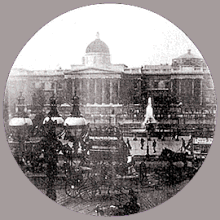

The following is an overview of the events of 1890 in film, including a list of films released and notable births and deaths.
| |||
|---|---|---|---|
| +... |
| Years in film |
|---|
 |
| 19th century |
| 1870s |


The following is an overview of the events of 1890 in film, including a list of films released and notable births and deaths.
| Month | Date | Name | Country | Profession | Died | |
| January | 10 | Pina Menichelli | Italy | Actress | 1984 | |
| 30 | Bruno Kastner | Germany | Actor | 1932 | ||
| February | 17 | Sol Lesser | US | Producer | 1980 | |
| 18 | Edward Arnold | US | Actor | 1956 | ||
| 18 | Adolphe Menjou | US | Actor | 1963 | ||
| 24 | Marjorie Main | US | Actress | 1975 | ||
| March | 3 | Edmund Lowe | US | Actor | 1971 | |
| 17 | Ted Adams | US | Actor | 1973 | ||
| 20 | Fania Marinoff | US | Actress | 1971 | ||
| April | 26 | Edgar Kennedy | US | Actor | 1948 | |
| May | 7 | George Archainbaud | France | Director | 1959 | |
| 23 | Herbert Marshall | UK | Actor | 1966 | ||
| June | 1 | Frank Morgan | US | Actor | 1949 | |
| 10 | William A. Seiter | US | Director | 1964 | ||
| 14 | May Allison | US | Actress | 1989 | ||
| 16 | Stan Laurel | UK | Actor | 1965 | ||
| 18 | Gideon Wahlberg | Sweden | Actor, screenwriter, director | 1948 | ||
| 25 | Charlotte Greenwood | US | Actress, dancer | 1977 | ||
| August | 2 | Marin Sais | US | Actress | 1971 | |
| 22 | Cecil Kellaway | South Africa | Actor | 1973 | ||
| 27 | Man Ray | US | Photographer, Director | 1976 | ||
| September | 4 | Gunnar Sommerfeldt | Denmark | Actor, director | 1947 | |
| 4 | Naima Wifstrand | Sweden | Singer, Actress, Composer, Director | 1968 | ||
| October | 1 | Alice Joyce | US | Actress | 1955 | |
| 1 | Stanley Holloway | UK | Actor | 1982 | ||
| 2 | Groucho Marx | US | Comedian, Actor | 1977 | ||
| 3 | Henry Hull | US | Actor | 1977 | ||
| 6 | Jack Rockwell | US | Actor | 1947 | ||
| November | 20 | Robert Armstrong | US | Actor | 1973 | |
![]() Media related to 1890 in film at Wikimedia Commons
Media related to 1890 in film at Wikimedia Commons

The Lumière brothers, Auguste Marie Louis Nicolas Lumière and Louis Jean Lumière, were French manufacturers of photography equipment, best known for their Cinématographe motion picture system and the short films they produced between 1895 and 1905, which places them among the earliest filmmakers.
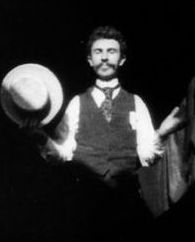
William Kennedy Laurie Dickson was a British-American inventor who devised an early motion picture camera under the employment of Thomas Edison.
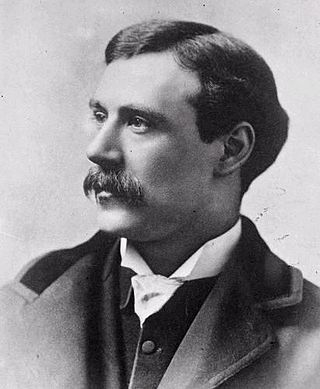
William Friese-Greene was a prolific English inventor and professional photographer. He was known as a pioneer in the field of motion pictures, having devised a series of cameras between 1888–1891 and shot moving pictures with them in London. He went on to patent an early two-colour filming process in 1905. Wealth came with inventions in printing, including phototypesetting and a method of printing without ink, and from a chain of photographic studios. However, Friese-Greene spent all his money on inventing, went bankrupt three times, was jailed once, and died in poverty.
The following is an overview of the events of 1895 in film, including a list of films released and notable births.
A movie camera is a type of photographic camera that rapidly takes a sequence of photographs, either onto film stock or an image sensor, in order to produce a moving image to display on a screen. In contrast to the still camera, which captures a single image at a time, the movie camera takes a series of images by way of an intermittent mechanism or by electronic means; each image is a frame of film or video. The frames are projected through a movie projector or a video projector at a specific frame rate to show the moving picture. When projected at a high enough frame rate, the persistence of vision allows the eyes and brain of the viewer to merge the separate frames into a continuous moving picture.
The following is an overview of the events of 1892 in film, including a list of films released and notable births.
The following is an overview of the events of 1891 in film, including a list of films released and notable births.

Louis Aimé Augustin Le Prince was a French artist and the inventor of an early motion-picture camera, and director of Roundhay Garden Scene.
The following is an overview of the events of 1893 in film, including a list of films released and notable births.

Major Woodville Latham (1837–1911) was an ordnance officer of the Confederacy during the American Civil War and professor of chemistry at West Virginia University. He was significant in the development of early film technology.
The following is an overview of the events of 1889 in film, including a list of films released and notable births.
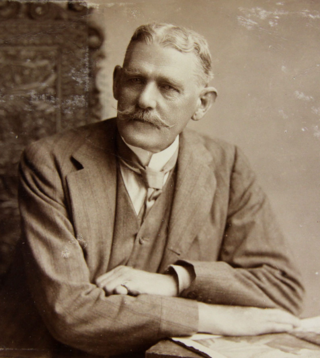
Wordsworth Donisthorpe was an English barrister, individualist anarchist and inventor, pioneer of cinematography and chess enthusiast.

Monkeyshines is a series of experimental short silent films made to test the original cylinder format of the Kinetoscope, and are believed to be the first films shot in the United States.
The decade of the 1890s in film involved some significant events.
Leisurely Pedestrians, Open Topped Buses and Hansom Cabs with Trotting Horses is a 1889 British short silent actuality film, shot by inventor and film pioneer William Friese-Greene. The film depicts life at Hyde Park Corner in London. Hyde Park Corner is claimed to be the first film set in London, as well as the first to be filmed on celluloid, although Louis Le Prince successfully shot on glass plate before 18 August 1887, and on paper negative in October 1888. It may nonetheless be the first moving picture film on celluloid and the first shot in London. It was shown mainly to several photographic journalists who saw it during their lifetime—including Thomas Bedding, J. Hay Taylor and Theodore Brown. It is now considered a lost film with only 6 possible frames surviving today.
William Carr Crofts (1846–1894) was an English architect and entrepreneur who was a photographic pioneer.
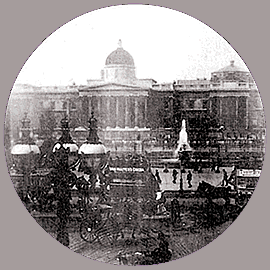
London's Trafalgar Square is an 1890 British short silent actuality film, shot by inventors and film pioneers Wordsworth Donisthorpe and William Carr Crofts at approximately 10 frames per second with an oval or circular frame on celuloid film using their 'kinesigraph' camera, showing traffic at Trafalgar Square in London. The surviving ten frames of film are the earliest known motion picture of the city.
Arthur Albert 'Esme' Collings was an English photographer, miniaturist and the first of the loose association of early film pioneers dubbed the Brighton School by French film historian Georges Sadoul. Collings, whose interest in cinematography may have stemmed from his business association with fellow film pioneer William Friese-Greene, was only active in film production for about a year, has left little trace and is, according to film historian Rachael Low, of local importance only.
Events in 1876 in animation.